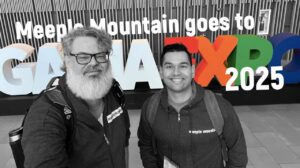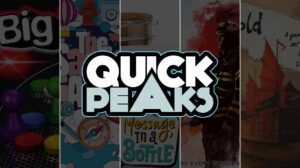Disclosure: Meeple Mountain received a free copy of this product in exchange for an honest, unbiased review. This review is not intended to be an endorsement.
Paws, Claws and Culinary Chaos
Flamecraft took the world by storm in 2022 with the beautiful, whimsical, and inviting art of Sandara Tang. It’s no surprise that Critter Kitchen is positioned to follow the same wide appeal and popularity trajectory. Though this game comes from different designers—the talented minds of Alex Cutler and Peter C. Hayward—it’s hard not to compare the two. The concept of cuddly, anthropomorphic animals gathering and cooking is a recipe for success, drawing in gamers of all skill levels. It’s nearly impossible to walk by without taking a second glance.. Add this to the recipe books among the likes of Flock Together, River Valley Glassworks, Café Baras, Harvest, Perch and Creature Comforts.
Describing the game’s mechanisms is like explaining a complicated recipe: it’s a mix of action selection, contracts, and silent bidding, with a sprinkle of push-your-luck, all simmering together to create a delicious final product. But does it serve up a satisfying experience, or does it fall flat like an overcooked, chewy New York Strip? In the culinary fashion of Top Chef, let’s see how this dish stacks up to the judges’ panel!

Whiskers and Whisks
Critter Kitchen is played over seven rounds, where players secretly select three locations to send their chefs. Each chef has a specific speed and carry weight—where the slowest can carry the most while the fastest can barely handle a garnish. Players will gather different qualities and quantities of ingredients to whip up mid-game scoring dish challenges and prepare for the grand finale: the final critic meal.
Among the ingredients are spices that can double individual values (every dish needs a little extra zing) and soups that act as wilds for dish challenges—perfect for those last-minute “I forgot to buy the mushrooms” moments. Turn order is crucial, as ingredients are randomly allocated among locations, and the cooking area gets crowded faster than a brunch spot’s kitchen on Mother’s Day.
Players are also assigned unique chef abilities, and they can recruit additional one-round-use “zous” chefs to squeeze a bit more juice out of the following round. The final critic meal is where the real feast happens, as players plate their finest ingredients to impress the critic and rack up stars. The chef with the most stars is crowned Top Chef and earns the right to flaunt their culinary skills.

Stirring Up the Fun
The main course of this dish has to be the theme. As mentioned earlier, the success of Flamecraft stemmed from its warm and inviting art, making the game as approachable as a well-seasoned home-cooked meal. Though both games aren’t necessarily hard to learn, Flamecraft, like Cascadia and Nova Luna before it, helped define the genre of “cozy gaming.” Similarly, Critter Kitchen is a game that can easily hook non-gamers just from the box alone. Open up all the adorable components, and the buy-in is pretty much guaranteed.
I relished the humor of the animal puns, including Anthony Boar-dain and Jamie Owl-liver—a fun nod for fans of the culinary world. But how does it play? Well, like a perfectly executed soufflé, it rises to the occasion. The round structure is fairly static, allowing familiarity to draw players in, while the variable ingredients keep things fresh.

The Midnight Market location was one of my favorites, as it added a touch of “push your luck,” where players committed chefs before the ingredients were drawn for that location. There were instances of soft tension when players were beaten out on ingredients due to their chefs’ speeds or when too many cooks were in the kitchen. This is probably one of the few downfalls, as some turns may leave players empty-handed, which can feel bad. However, this is quickly remedied since losing out on one location still leaves two more chances to grab the good stuff (players have three chefs to place each round).
Another minor bump is explaining the scoring criteria for the endgame. It can be a bit complicated, and misunderstandings may prove costly to a player’s final score. For Euro gamers, there’s the freedom to ‘math out’ your ingredients, ensuring you serve the most optimal meal. Still, the game remains light and breezy—more like a quick stir-fry than an all-day slow roast. It accomplishes its intended purpose: to be a light, family-friendly culinary adventure.
Over multiple plays, I tried to identify different strategies. While there aren’t many, that’s okay—this isn’t a high-stakes fine dining experience; it’s more of a fun food truck outing. The game is short enough to enjoy but still offers just enough depth to keep players engaged. The base game alone probably won’t stay in my pantry forever, but with so much expandable content, the future menus promise to stay fresh and interesting.
Critter Kitchen is the hot soup coming by, and trust me—it’s absolutely worth a taste. Bon appétit!












Add Comment